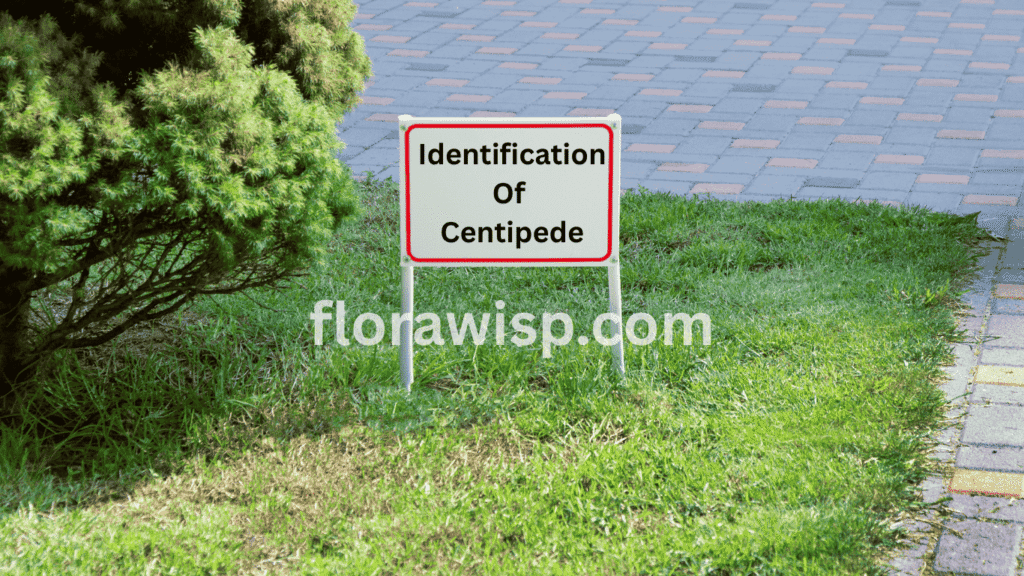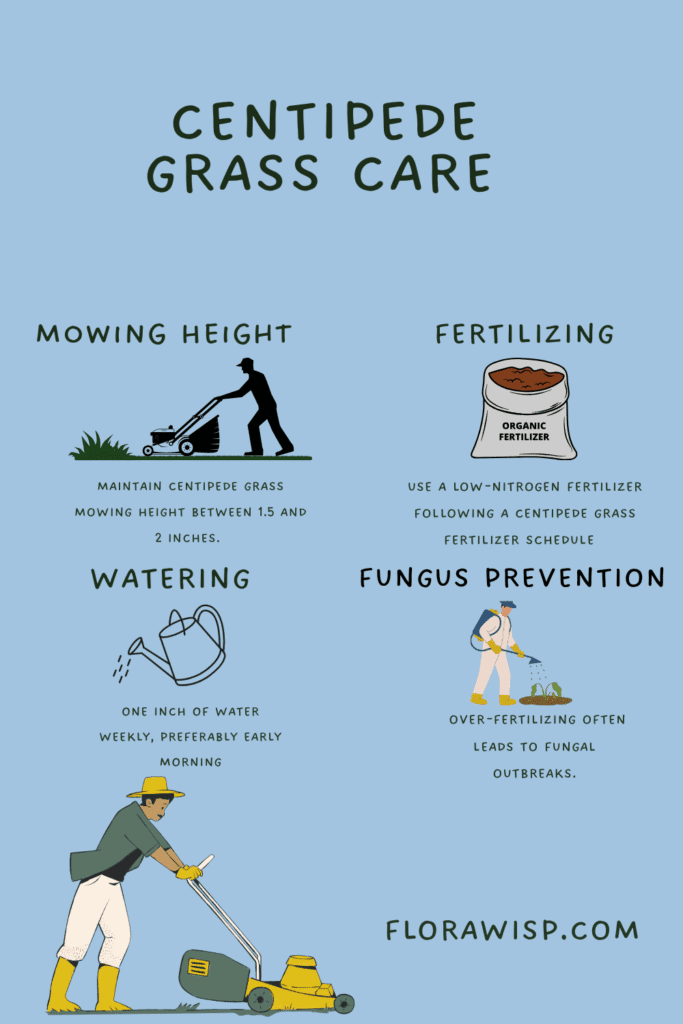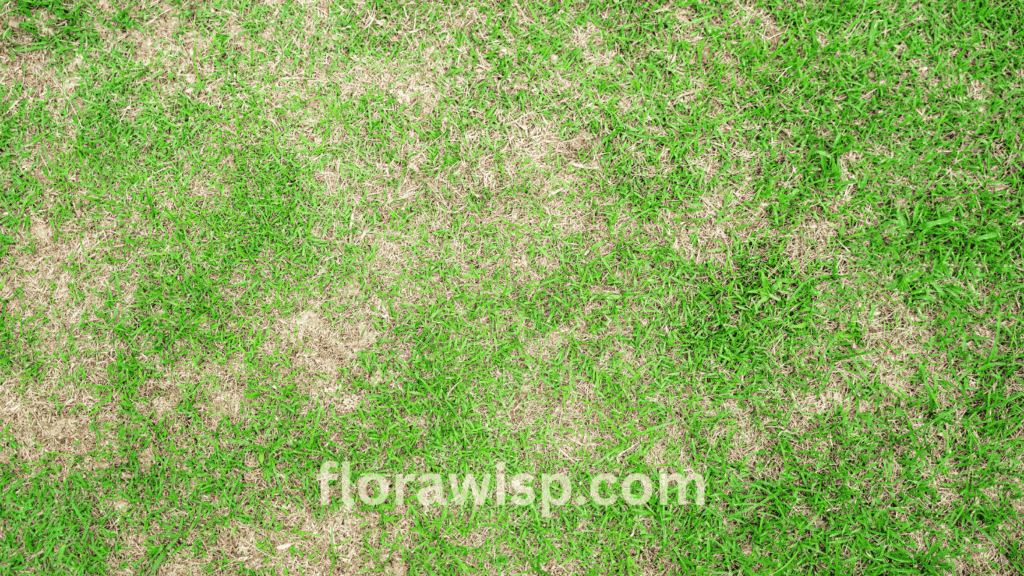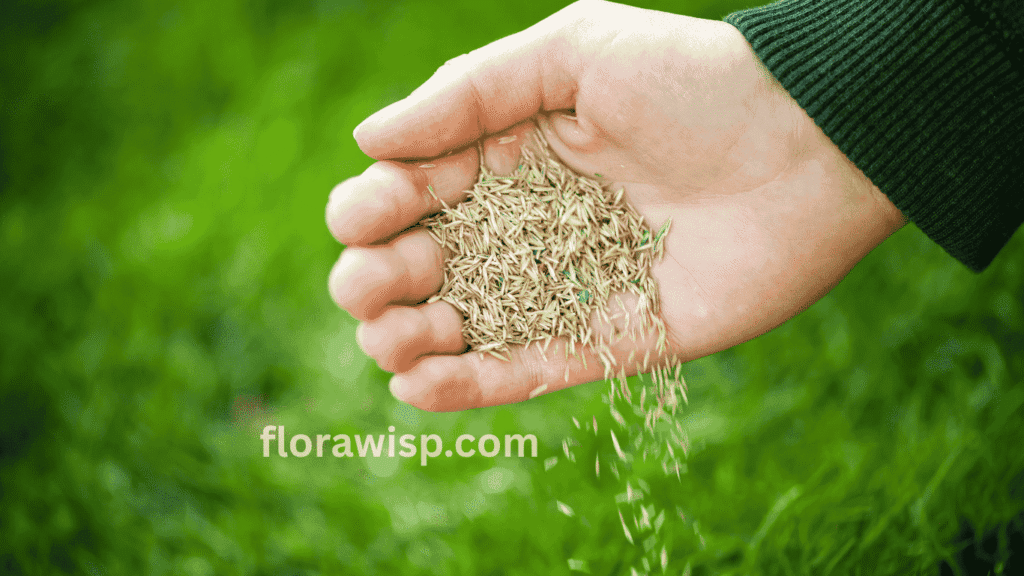Centipede grass is a light-green, low-growing warm-season turf that thrives in acidic, sandy soils, making it one of the best choices for Southern lawns and warm climates. Known for its coarse blades, creeping stolons, and minimal maintenance needs, a centipede lawn forms a dense carpet that naturally resists weeds while staying soft underfoot. Proper identification is easy its flat, apple-green blades spread horizontally and grow to about 4–6 inches, though the ideal mowing height is 1.5–2 inches to maintain thickness and color. If your centipede grass is thinning out, compacted soil, low sunlight, or overwatering are usually the culprits; core aeration, overseeding, and light pruning of shaded areas quickly restore density.
To make centipede grass spread faster and grow thicker, keep the soil slightly acidic (pH 5.0–6.0), mow regularly, water deeply once a week, and apply a low-nitrogen fertilizer in late spring. While it grows best in full sun, it tolerates light shade, though heavy shade may require mixing it with compatible grasses like fescue for coverage. The growing season peaks in late spring through summer when soil temperatures rise above 70°F, making this the perfect time for seeding, plugging, or sod installation. Among the types of centipede grass, TifBlair Centipede Grass stands out for superior cold tolerance and faster establishment, making it a go-to option for homeowners looking to maintain a lush, resilient lawn with minimal effort.
In This Article
1️. Understanding The Centipede

I’ve personally nurtured centipede grass patches across varying soil conditions from sandy loam in coastal areas to slightly acidic inland soils. What makes centipede grass stand out is its:
- Distinctive Appearance: With its light green to apple-green, coarse-textured blades, centipede grass creates a soft, inviting lawn that’s visually appealing and comfortable for barefoot walks.
- Creeping Growth Habit: It spreads slowly via stolons, forming a dense, low-growing carpet that naturally helps suppress weeds and reduce soil erosion.
- Shallow Root System: While its roots are shallow and thrive in consistent moisture, centipede grass struggles in prolonged droughts and requires attentive watering during dry periods.
- Soil Preference: Prefers acidic soils with a pH range of 5.0–6.0, where it establishes best and maintains a vibrant color.
Unlike other grasses Bermuda, St Augustine grass , centipedes don’t demand your weekends. It thrives on low fertilization, minimal mowing, and doesn’t need constant babying. That said, don’t confuse low maintenance with neglect. It rewards care with lushness but punishes ignorance with bare patches.
2️. Centipede Grass vs Bermuda Grass
Centipede grass and Bermuda grass are two of the most widely planted turf options, but they cater to very different needs and growing conditions. If you’re deciding between them, it’s crucial to understand their core differences from maintenance levels and soil preferences to how they handle foot traffic and shade. I’ve personally tested both grasses in the same backyard, observing how they perform under identical conditions. Here’s a detailed comparison chart to help you make an informed choice:
| Feature | Centipede Grass | Bermuda Grass |
| Maintenance | Low | High |
| Growth | Slow | Rapid |
| Shade Tolerance | Moderate | Low |
| Foot Traffic Tolerance | Low | High |
| Soil Preference | Acidic | Well-drained |
After extensive hands-on testing, it’s clear that centipede grass is ideal for homeowners looking for a relaxed, natural lawn that requires minimal upkeep. On the flip side, Bermuda grass thrives in high-traffic areas like sports fields and playgrounds, where durability and resilience are paramount. By understanding these differences, you can choose the grass that perfectly fits your yard’s needs and your lawn care goals. For long-term success, explore our tips on Evergreen Grass Care to keep your lawn thriving through every season.
3️. Centipede Grass vs St. Augustine & Zoysia
Selecting the right grass for your lawn goes beyond personal preference; it’s a decision shaped by factors like soil pH, climate tolerance, sun exposure, and long-term maintenance costs. Each turf type brings its own strengths and challenges, and understanding these nuances can save you time, money, and effort. Let’s explore how these grasses stack up in real-world lawn performance.
St. Augustine Grass: known for its thick, carpet-like appearance and thrives in shaded and humid conditions. In regions like Texas, where heat and humidity dominate, St. Augustine grass in Texas has proven to be a popular choice but one that comes with high demands. It requires regular mowing, high nitrogen fertilization, and constant monitoring for pests and diseases. It’s a high-maintenance choice with a lush payoff.
Zoysia Grass: Zoysia offers a luxurious, dense texture and moderate shade tolerance. It grows slower and needs more care to establish, but once mature, it provides a resilient, soft lawn. Its maintenance curve is higher, but the rewards are visually impressive.
Centipede Grass: For a low-maintenance, sun-loving option, centipede grass shines. It flourishes in full sun to partial shade and is forgiving for gardeners who prefer a “plant and relax” approach. In my experience, centipede grass consistently outperforms both St. Augustine and Zoysia in less-managed zones, though it does thin out quicker in high-traffic areas.
4️. Identification Of Centipede

Know It Before You Sow It; If you’re new to this grass, you might confuse it with Bermuda or even Zoysia. Here’s what to look for:
- Blade Color: Features a distinctive light green to apple green hue, making it stand out from other warm-season grasses. Its color holds well through the growing season, even in challenging soil conditions.
- Texture: The blades are coarse and slightly wider than Bermuda, giving lawns a fuller, more textured appearance that’s less prone to scalping from mowing.
- Growth Habit: It spreads slowly through stolons, forming a dense, mat-like coverage that naturally suppresses weeds with minimal maintenance.
- Height: This grass is best maintained at a height of 1.5–2 inches, optimizing root health and enhancing its natural resilience against heat and drought.
I often recommend homeowners walk barefoot across their lawns. It’s the best way to truly experience the difference. This grass offers a noticeably softer, cooler feel underfoot compared to other turf types, though it lacks the thick, spongy cushion of Zoysia. Its coarse texture feels natural and firm, ideal for those who prefer a simpler, barefoot-friendly lawn. Plus, its soft blades stay cooler in the summer sun, making barefoot strolls a welcome part of any gardener’s day.
5. How to Spread Centipede Grass: Seeds, Sod & Plugs
Spreading centipede grass successfully depends on matching the method to your yard’s conditions, climate, and budget. In my experience, three methods work best: seeds, sod, and plugs each offering a unique path to a lush, low-maintenance lawn.
Seeds are ideal for full-sun areas with sandy, acidic soil. Centipede grass seeds germinate slowly, usually in 14–21 days, and need consistent moisture until they establish. I’ve seen the best results when seeding in late spring with soil temperatures above 70°F. Use a light rake to ensure seed-to-soil contact and avoid heavy foot traffic during the early weeks.
Sod provides instant coverage but is more expensive. I only recommend sod if erosion is an issue or if you need quick results, like prepping a rental property. It establishes well when installed tightly, rolled, and kept consistently moist.
Plugs offer a cost-effective middle ground. They’re perfect for smaller areas or filling in thin spots. In partial shade, I’ve planted plugs in staggered rows spaced 12 inches apart most filled in within a season. For shady areas, plugs outperformed seeds, while sunny lawns flourished with all three methods.
Choose your method based on sunlight, soil, and how fast you want results. With good prep and proper watering, each method can lead to a thriving centipede lawn.
6. Pros and Cons of Centipede Grass
Centipede grass is often called the “lazy man’s grass,” but that nickname only tells part of the story. Here’s a clear-eyed breakdown of the advantages and challenges I’ve seen while growing and maintaining this turf over the years.
Pros
- Low Maintenance: Needs less mowing and fertilizer than Bermuda or St. Augustine. I only mow every 10–14 days and fertilize once a year.
- Weed Resistance: Once established, its dense mat crowds out most weeds naturally.
- Acid-Loving: Thrives in acidic soils (pH 5.0–6.0), common in Southern and coastal regions.
- Sun-Loving but Tolerates Light Shade: Performs best with 6+ hours of sun but holds its color in lightly shaded areas too.
Cons
- Poor Traffic Tolerance: It’s not suited for playgrounds or high-traffic backyards. In my own yard, paths with frequent use thinned out quickly.
- Slow Recovery: If damaged, it takes longer to bounce back than Bermuda or Zoysia.
- Thatch Risk: Over-fertilizing causes buildup, leading to shallow roots and fungus issues.
- Cold Sensitivity: While TifBlair improves cold tolerance, standard varieties still suffer in frost-prone zones.
If you’re looking for a lush lawn that’s simple to care for and you don’t need heavy foot traffic durability, centipede grass delivers long-term beauty with minimal fuss.
7. Essential Centipede Care

Understanding the delicate balance of mowing, fertilizing, and watering is key to maintaining a healthy centipede grass lawn that thrives without costly issues.
- Mowing Height: Maintain centipede grass mowing height between 1.5 and 2 inches. Keeping mower blades sharp helps avoid frayed leaf tips and reduces stress on the grass.
- Fertilizing: I use a low-nitrogen fertilizer following a centipede grass fertilizer schedule typically starting in late spring (May) in Florida applying sparingly to prevent overgrowth.
- Watering: One inch of water weekly, preferably early morning, helps minimize centipede grass fungus risks by reducing prolonged leaf wetness.
- Fungus Prevention: Over-fertilizing often leads to fungal outbreaks; less is more when fertilizing centipede grass.
I’ve seen many DIYers over-fertilize, which often invites centipede grass fungus and weakens the lawn’s natural defenses. With centipede grass, a cautious, balanced approach always yields the best long-term results.
8. Centipede Grass Problems
Even though centipede grass is low-maintenance, it’s not trouble-free. Over the years, I’ve encountered several recurring issues. Recognizing them early and acting smartly can save your lawn from serious setbacks.
Weeds: When a centipede gets weak, weeds move in fast. Broadleaf weeds like clover and spurge can dominate thin areas. I’ve had success using post-emergent herbicides during the growing season and applying pre-emergents in spring.
Fungal Diseases: Root rot and brown patch often stem from overwatering or too much nitrogen. I treat affected areas by cutting watering to once per week, applying a fungicide, and switching to organic compost instead of chemical fertilizer.
Thatch Build-Up: A thick thatch layer chokes out roots and invites pests. I dethatch in late spring using a manual rake and compost the pulled material. Keeping fertilization light also helps prevent thatch from forming in the first place.
By staying ahead of these problems, your centipede lawn can stay vibrant and resilient year-round.
Centipede Grass Thinning Out? Here’s Why & What to Do

Thinning in centipede grass is common and usually signals poor soil conditions, over-shading, or overwatering. I’ve dealt with this in my own yard, especially under tree canopies. The fix starts with improving airflow and light: prune overhead branches and remove leaf buildup. Next, aerate the soil to loosen compaction, then overseed with quality centipede seed and water lightly until new blades emerge. For shady areas, consider mixing in shade-tolerant grasses. Thin areas often rebound in 4–6 weeks with consistent care.
Pre-Emergent for Centipede Grass: What Works Best?
Centipede grass benefits greatly from timely pre-emergent weed control. I apply a granular pre-emergent herbicide like prodiamine in early spring (when soil hits 55°F). It prevents crabgrass and broadleaf weeds before they sprout. One spring, I skipped this step and ended up battling weeds for months. Always water the product in well after application. Avoid pre-emergents when overseeding, as they block all seeds—grass and weeds alike. For organic care, corn gluten meal offers mild protection, though not as strong as chemical options.
9. Overseeding Centipede

Overseeding centipede grass is most effective in late spring to early summer when soil temperatures consistently reach above 70°F, ensuring optimal seed germination and establishment.
- Mow low to the recommended centipede grass mowing height, around 1.5 inches, to expose soil and encourage seed-to-soil contact.
- Aerate to relieve compaction, improving water and nutrient absorption.
- Broadcast seed evenly, preferably using quality centipede grass seeds for better germination.
- Water lightly but consistently to maintain moisture without promoting centipede grass fungus.
- Overseeding revitalizes lawns that have thinned from wear, drought, or pest damage, enhancing density and resilience.
10. Centipede Grass in Florida: Tips for a Healthy Lawn
This grass is a popular choice across Florida due to its tolerance for heat and sandy, acidic soils. From my experience working in various Florida regions, it performs best in well-drained areas with plenty of sunlight. Avoid planting in compacted or poorly drained soils, as this can lead to root rot and fungal diseases common in Florida’s humid climate.
To keep your lawn healthy, water deeply but infrequently aim for about one inch per week early in the morning to reduce fungus risk. Regular mowing at the recommended height and following a balanced fertilizer schedule tailored for Florida’s conditions will keep your centipede grass lush and vibrant year-round.
If you’re managing centipede grass in a slightly different Southern environment with red clay soils and variable rainfall, check out our detailed guide on Centipede Grass in Georgia.
11. Centipede Lawn Care Calendar
Maintaining a healthy lawn requires a strategic approach tailored to each season’s unique challenges and growth patterns.
Spring: Begin with a low-nitrogen fertilizer to encourage steady growth. Start mowing when grass reaches about 2 inches. Early spring aeration improves soil oxygen and nutrient uptake.
Summer: Water early in the morning to reduce evaporation and prevent fungal diseases common in humid climates. Maintain mowing height between 1.5 and 2 inches to avoid stressing the grass during heat. Apply pre-emergent herbicides to control summer weeds.
Fall: Gradually reduce watering frequency but increase depth to strengthen roots. Overseed thinning areas when soil temperatures remain warm. Avoid heavy fertilizing to prepare grass for dormancy.
Winter: Minimize traffic on dormant grass to prevent damage. Keep leaves cleared to allow sunlight penetration and reduce fungal growth.
Following this calendar optimizes centipede grass health and longevity year-round.
FAQs
Q. What is centipede grass
Centipede grass is a warm-season, low-maintenance turfgrass known for its light green color, slow growth, and excellent heat tolerance. It thrives in acidic, sandy soils and is ideal for Southern lawns. Popular for its drought resistance and minimal mowing needs, centipede grass creates a dense, weed-resistant lawn with minimal fertilization.
Q. What does centipede grass look like?
Centipede grass has a light green color with flat, coarse blades that spread outward through surface runners. It grows low to the ground, creating a thick, tidy mat across the lawn. Its soft hue and horizontal growth make it easy to spot compared to other grasses like Bermuda or Zoysia.
Q. How to make centipede grass spread?
Mow it regularly at about 1.5 to 2 inches, water it deeply once or twice a week, and apply a balanced fertilizer in late spring. I’ve noticed that slightly acidic soil really helps it grow out faster. Keep nitrogen levels low to prevent too much thatch and to encourage steady spreading through stolons.
Q. Does centipede grass take over bahia?
Centipede grass can gradually move into areas where bahia grass grows, especially when it’s well cared for. Still, it doesn’t usually overtake strong bahia patches on its own. I’ve tried it myself and unless you put in extra effort like edging and reseeding, bahia usually holds its ground. Centipede prefers a bit more acidity, which gives it an edge in the right soil.
Q. When to fertilize centipede grass?
The best time to fertilize is in late spring, using a low-nitrogen, slow-release formula. One light application each year is usually enough. I use a 5-5-15 mix on sandy soil to promote steady growth without overfeeding. Too much nitrogen often leads to thatch and weakens the grass over time.
Q. Will centipede grass grow in shade?
Centipede grass can manage in light or moderate shade, but it definitely prefers sunny spots. In heavier shade, I’ve seen it get thin and patchy. My own lawn has a shaded section where it struggled, and I had to mix in more shade-tolerant grass to keep it looking full. It does best where it gets several hours of direct sunlight daily.
Q. How Tall Does Centipede Grass Grow?
Centipede grass typically grows to 4–6 inches in height, but it’s best maintained at 1.5–2 inches for optimal health and appearance. Mowing it too tall leads to scalping and encourages thatch buildup, while mowing too low stresses the plant. I keep my mower at 2 inches and sharpen blades every few weeks. This keeps the grass tidy, soft underfoot, and dense enough to resist weeds.
Conclusion
In my years of tending lawns, centipede grass has consistently proven to be the best option for homeowners who value simplicity and elegance. Whether you’re battling weeds, comparing grass types, or just want a low-maintenance lawn that performs well season after season, centipede grass delivers.
To get the most out of it, follow a proper care routine and choose the best fertilizer for centipede grass based on your region’s needs and soil health. With the right approach, you’ll grow a lawn that not only thrives but feels like a true extension of your home.
References
University of Florida IFAS Extension
University of Georgia Extension
Gardener, M.Sc. Horticulture
Elara Bennet is a gardening writer from Austin, TX, passionate about sustainable lawns and blooms. Read full bio →








